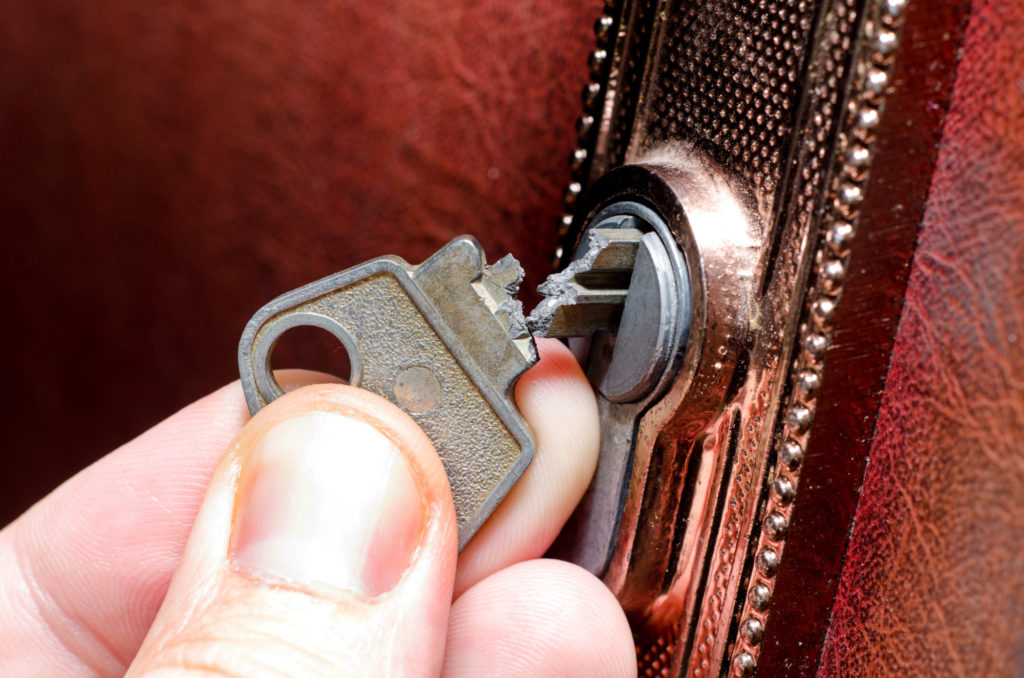Most homeowners are familiar with the two-worded knee-jerk reaction to any door lock problem: “Oh. Crap.”
These issues pop up every so often, and every homeowner is forced to deal with figuring out what the issue is and how to properly fix it.
 However, it’s not enough to do the bare minimum to temporarily fix the problem and risk your overall safety over time. As taboo as it may be to mention, your lack of a properly-functioning lock can result in an attack or robbery within your home.
However, it’s not enough to do the bare minimum to temporarily fix the problem and risk your overall safety over time. As taboo as it may be to mention, your lack of a properly-functioning lock can result in an attack or robbery within your home.
The best way to combat this is to fix it from the start; here are seven common door lock problems and how to best fix them while you wait for a reliable and trusted locksmith to arrive.
7 Typical Door Lock Problems
Don’t put yourself in a situation that risks your family’s safety. Read up on these common door lock problems and the best way to fix them.
Loose Door Locks
If you notice there are loose portions of your doorknobs, such as the lock or handle, don’t go another day without fixing it. Any loose part on the door lock’s system will weaken its effectiveness and leave your house at risk of a break-in.
Loosening happens with any door lock over time, due to the simple wear and tear that comes with using it several times each day.
The resolution to this issue can be as simple as tightening a few loose screws or as complicated as having broken screws that need to be replaced.
If you tighten all screws and still notice the door lock is loose, find a locksmith to check it out for further inspection.
Jagged Door Locks
Sometimes locks are improperly installed and don’t end up aligning with the strike plate on the door itself.
That results in your door not properly closing (or not closing at all), which leaves your door exposed to whoever may choose to enter it. Many may choose to leave this unattended and rely on the door’s lock bolt to keep the door shut. However, over time, your lock bolt will become damaged as well.
To fix this, search your door lock and the entire door for loose screws that may be causing it to go off-center (thus, not aligning properly with the door frame).
Also, check the strike plate to see if it’s unaligned. Simply fixing that may do the trick.
Door Lock Jam
Over time you may begin to notice your door lock getting stuck or jammed in one position.
This may be caused by debris that’s built up over time, which won’t allow the lock to move properly. A jam can also be caused by a damaged lock bolt.
To clear any debris that may be in the way, find a useful door lock lubricant that you can use to remove the debris from the key slot in the lock.
If that doesn’t work and it becomes obvious the problem is due to a broken bolt, call an expert right away to have it replaced.
Turning the Key Doesn’t Lock the Door
Everyone is familiar with the muscle memory of locking a door that properly functions. You stick the key in, turn the key, apply a bit more force to lock the door, and then pull the key out.
However, there may be a time when the key turns but won’t actually allow you to lock the door, regardless of how much force you use. The cause can be a damaged bolt or portion of the lock within the system, which should be brought to the attention of a trained and licensed professional locksmith.
The Entire Lock Cylinder Turns
In this scenario, you place the key in the slot to lock the door, but the entire lock cylinder turns with the key.
That means there are loose or damaged screws that need to be tended to.
Depending on the lock you use, that could be a quick DIY fix with tightening a few screws or a job by a trained locksmith to uncover the parts that need to be replaced.
The Key Breaks in the Lock
This problem is more common than you might imagine, and if you’re not careful, it can happen to you as well.
Truth be told, there’s not much you can do on your end to fix this problem once it happens. Attempting to remove the broken key in the key slot yourself can result in even greater damage.
Better safe than sorry; give your trusted locksmith a call and see what the best course of action is from there.
Slow Door Locks
If you notice a lag in the door lock as you turn the key or door handle, this may be a sign for the inevitable door jam listed above if not taken care of immediately.
Fortunately, you can fix this problem by lubricating the lock with a spray (graphite or silicone) to help the lock turn properly again.
If you don’t notice a significant difference after spraying, there are bigger problems at hand. It could be time to switch out the lock entirely, so if DIY methods don’t work, it may be time to replace the door lock system.
Play It Safe, Call an Expert
Sadly, door lock problems are a part of life; they happen to everyone.
Fortunately, there are experts out there who are professionally trained to rid you of those problems and give your sense of security back to you.
Next time you’re starting to see signs of door lock dilemmas, play it safe and call your local lock expert for their opinion.
Leave a Reply